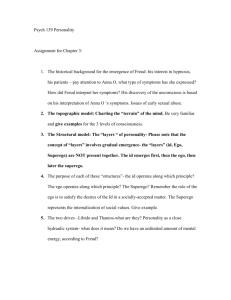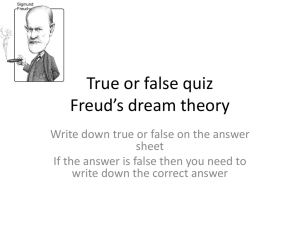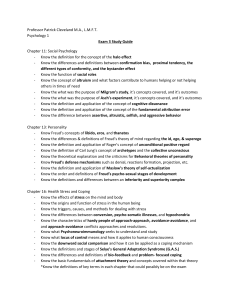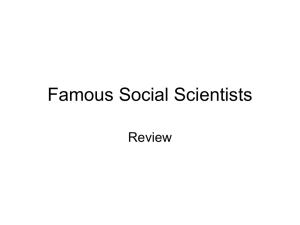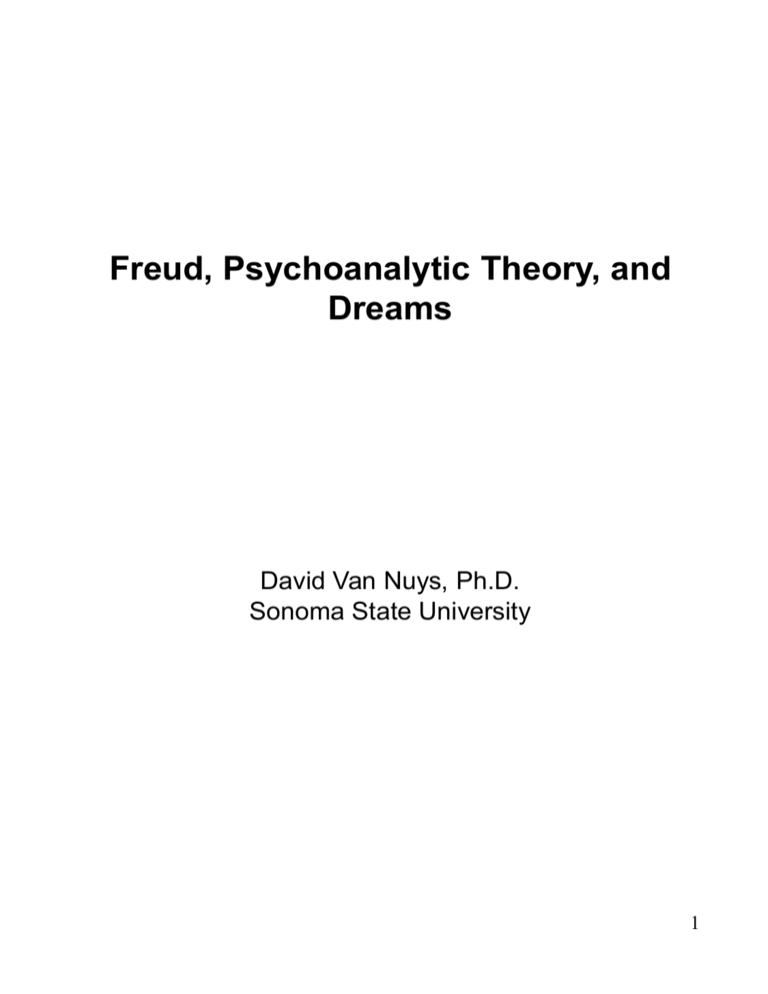
Freud, Psychoanalytic Theory, and
Dreams
David Van Nuys, Ph.D.
Sonoma State University
1
Relevance Today
•
•
•
•
•
Fashionable to attack Freud
– Outdated
– Unscientific
– Sexist
Nevertheless, all major subsequent theories have
been based on his revolutionary, pioneering work
He was nominated for the Nobel Prize in Literature
for his seminal book, The Interpretation of Dreams
which appeared in 1900.
Looking back in 1930, he said of The Interpretation
of Dreams, that it contained “the most valuable of all
the discoveries it has been my good fortune to
make. Insight such as this falls to one’s lot but once
in a lifetime.”
“I must affirm that dreams really have a meaning
and that a scientific procedure for interpreting them
is possible.”
2
Freud’s Life
•
•
•
•
•
•
•
•
•
Born 1865 in Freiberg, Moravia to Jacob, his woolmcerchant father. Mother was Jacob’s third wife.
In 1860, family moved to Vienna, where Freud grew
up and lived until 1938.
Vienna exciting place of opportunity and optimism.
In 1867, Jews granted political rights and accepted
into society.
Freud assimilated, identifying as a German.
Embraced humanistic values of political liberalism
and affirmed universal goals of rationality and
human freedom.
About the time he was 15, liberal political
atmosphere evaporated and anti-Semitism became
virulent. Freud’s hopes for assimilation shattered,
replaced by disappointment & bitterness.
Graduated from University of Vienna medical school
with strong interest in research but quickly married
and realized only private practice would provide
needed financial support.
Published well received scholarly papers on
neurological disorders.
Outbreak of WW II forced him to flee to London,
where he died a year later in 1939.
3
Freud’s theory is complex because:
•
•
•
He kept modifying it as he went along
He never presented a comprehensive summary of
his final views
His theory is more comprehensive than must since it
has a number of aspects. For example, he gives
us:
– A theory of motivation
– A theory of thinking (which includes dreaming,
etc.)
– A theory of personality development
(psychosexual theory)
– A theory of mental structures (id, ego, superego)
– A theory of psychopathology and symptom
formation
– A theory of psychotherapy
4
Two Fundamental Hypotheses
•
•
1. Principle of psychic determinism
– Nothing in nature happens by chance
– Nothing in the mind happens by chance
2. The unconscious
– Conscious rationality is the exception rather
than the rule in psychic processes
– Evidence for this is inferred from:
• Psychopathology - symptom formation
• Parapraxes, i.e. slips of the tongue, of the
pen, etc.
• Dreams
• Free association
• Hypnosis
– These two hypotheses interlock
5
The Drives
•
•
Link with biology
– Freud hoped to link up his thoeries with biological
knowledge
– We’re still not able to do that
– Freud used the term “instincts” in this regard but the
term is misleading in English
– Drive = Tension or excitation looking for release, i.e.
need --> motor activity --> gratification
Psychic energy & cathexis
– Freud postulates a psychic energy analogous to
physical energy
– Amount of psychic energy directed towards memories,
thoughts, and fantasies of an object is called
“cathexis”
• e.g. child’s mother is an object highly cathected
with psychic energy
– Two forms of drive energy (like ying/yang)
• Libido - sexual/erotic
• Thanatos - aggressive/destructive
• Freud assumes these are always fused but not
necessarily in the same amounts
– Cruelty may have ucs. erotic component
– Acts of love may have ucs. aggressive
6
component
Psychosexual Development
•
•
•
Stages
– Oral stage - First 1 1/2 years
• Flow of libido presumed to be in the mouth, lips,
tongue
– Anal stage - next 1 1/2 years
– Phallic stage - from 3 to 6 years
– Latency
– Mature adult genital stage
Fixation & Regression
– Freud’s analogy about the troops
– If a new pleasure proves unsatisfactory, the individual
reverts to one that is tried and true
• e.g. small child reverting to thumb sucking upon
birth of a sibling
Autoeroticism
– When object not available, such as breast, fingers
may substitute
– Frees child from domination of the environment but
also may be precursor to withdrawal from reality
– Aggressive drive too may reveal itself in the libidinal
zones
7
The Psychic Apparatus
•
•
•
Topographical system
– Conscious
– Preconscious
– Unconscious
Structural theory
– Id
– Ego - mediates between id & environment tests for what’s real
– Superego (develops around 5 or 6 years of age)
Ego Functions
– Motor control
– Perception
– Memory
– Affects
– Thinking (delay of gratification)
– Ego develops in response to maturation and
environment
– Importance of identification in ego development
8
Dream Formation
•
•
•
•
Dream springs from unacceptable, unconscious
wishes
– Sexual
– Aggressive
– Egoistic
Latent vs. Manifest content
Censorship
The Dream Work
– Condensation
– Displacement
– Representability
– Secondary revision
9
Function of The Dream
•
•
To protect sleep
Wish fulfillment
10
Primary and Secondary Process
Thinking
•
Secondary process thinking
– Rational
– Moral (influenced by superego)
– Logical
– Cause & effect
– Temporal
– Abstract
– Ability to delay gratification
– Verbal
11
Primary/Secondary Cont.
•
Primary Process Thinking (“Baby Thinking”)
– Tends toward immediate gratification
– Amoral
– Non-temporal
– Non-causal
– Concrete
– Visual
– Absence of negatives, conditionals, or other
qualifiers
– Opposites and contradictions may coexist
– Representation by allusion, analogy, or object
parts (pars pro toto)
– Displacement - substitution of one idea or image
by another one which associatively connected
with it
– Condensation - representation of several ideas
or images by a single word or image
– Symbolic - meanings relatively constant from
patient to patient
• Pair of sisters = breasts
• Journey or absence = death
12
My Position on Freud & Dreams
•
•
•
Agree
– Day residue
– Free association
– Primary process thinking
Disagree
– Sex/aggression as sole drives
– Censorship
– Wish fulfillment
I Favor Growth Model
– Expression of health (a la Taylor)
– Creativity
– Precognition
– Confirmation of growth
– Guidance and Advice
– Rehearsal for action
– Spiritual dimension
13
Freud vs. Jung Dream Theories
•
Freud
•
– View of Unconscious
• Dangerous
• Personal
unconscious
• Negative id
drives of
sex/aggression
– Function of dream
• Wish fulfillment
– Logic of dream
• Primary process
& censorship
– Analytic tool
• Free association
Jung
– View of Unconscious
• Potentially
dangerous force
of nature
• Personal &
Collective
unconscious
• Bright shadow
– Function of dream
• Compensation
– Logic of dream
• Language of
metaphor
– Analytic tool
• Amplification
14


